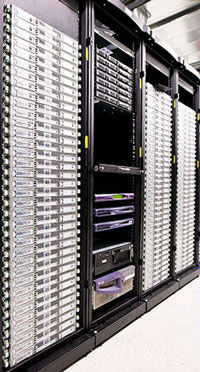 The question become how far away is safe and what do you need to efficiently transfer data. The data center across town will save you if your building catches fire, but won’t do much when an F5 tornado levels the entire town or the levee breaks and everything submerges. You need to get to a different geographical area where the threats are different than where you are now. Tornados aren’t likely to hit Denver and Biloxi at the same time. A big earthquake may shake San Francisco, but it’s not likely to be shaking Chicago at the same time.
The question become how far away is safe and what do you need to efficiently transfer data. The data center across town will save you if your building catches fire, but won’t do much when an F5 tornado levels the entire town or the levee breaks and everything submerges. You need to get to a different geographical area where the threats are different than where you are now. Tornados aren’t likely to hit Denver and Biloxi at the same time. A big earthquake may shake San Francisco, but it’s not likely to be shaking Chicago at the same time.Corporations with regional offices are well situated to back each other up. You may want to consider having each office back up data for a couple of other offices hundreds or thousands of miles away. It’s a lot of data flowing, but if one office gets taken out, you’ve got the data in at least two other places.
Having geographically diverse locations back up each other’s data fits well with the network topology you need anyway. Certainly, you want all of your locations to be able to communicate. Some companies do this through a private star network centered on their headquarters location. Others use a mesh network based on MPLS with each location connecting to the nearest POP in their city. That’s more robust because there is no single point of failure like you have with HQ coordinating all the traffic.
What you need for data backup is bandwidth and lots of it. With dedicated line services you are paying for the full capacity even though the lines mostly sit idle after hours. Those are the traditional times that IT departments do data backups anyway. You can load your lines to the max to transfer data files without affecting other business operations if you do this in the wee hours.
Other companies like the idea of data mirroring. This is a real time process that keeps two or more copies of a data set completely synchronized at different locations. The advantage is that you can recover almost instantly when you lose a facility. The tradeoff is that you’ll need much higher bandwidth levels than for backup file transfers that can take their time overnight.
What type of bandwidth is available to support your backup or mirroring needs? Most likely you’ll want fiber optic connections, although smaller organizations may get by with 100 Mbps Ethernet over Copper where it is available. Otherwise you’re looking at traditional SONET services that include OC-3 at 155 Mbps, OC-12 at 622 Mbps, OC-48 at 2.49 Gbps or OC-1921 at 9.95 Gbps. A good alternative is Carrier Ethernet service that is highly scalable and includes popular speeds such as 100 Mbps Fast Ethernet, 1000 Mbps Gigabit Ethernet (GigE) and 10,000 Mbps 10 Gigabit Ethernet ( 10 GigE).
Both SONET and Ethernet are widely available for long haul connections through competitive fiber optic carriers, plus last mile connections to high bandwidth MPLS networks with a regional or nationwide service footprint. Which topology you pick depends on how many locations you want to interconnect and how the pricing works out. Ethernet tends to be less expensive than SONET in most situations and MPLS networks have the advantage of offering more bandwidth at lower costs than most dedicated lines.
Fiber optic connections are also valuable if you are getting your storage in the cloud, as many companies are now doing. The advantage of cloud storage is that it gives you the geographical diversity you require, the security of a major data center and nearly unlimited resources as your data storage needs change. You’ll also avoid the capital expense and staffing required to run your own data centers.
Are you in need of robust high bandwidth connections to support your data backup and mirroring needs? If so, get pricing and availability of SONET and Ethernet fiber optic bandwidth services now. You may also wish to explore cloud storage options as another approach to disaster protection and recovery.

Note: Data center photo courtesy of Wikimedia Commons.

No comments:
Post a Comment